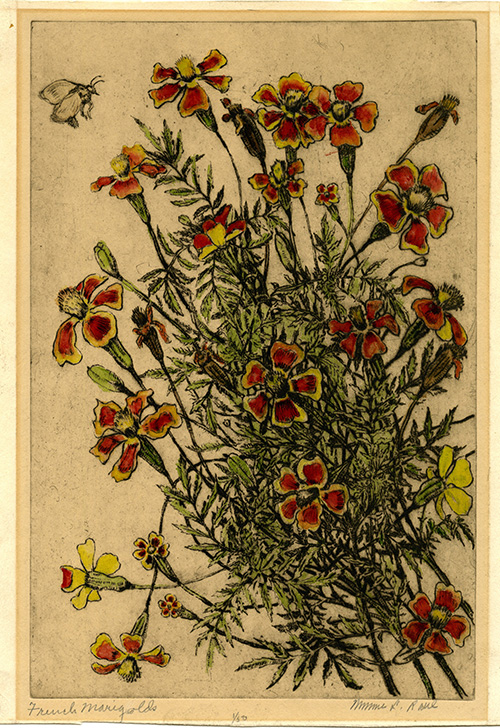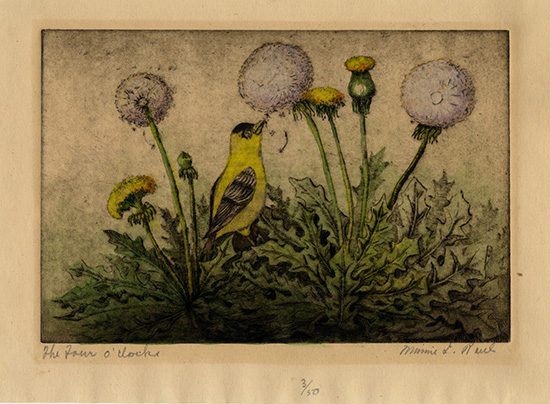April 18, 2019
Mary Nimmo Moran is one of the most famous female etchers in history. Less well known is Washington D.C. artist Minnie Briggs Raul, who used the same medium. Although their artistic styles are noticeably different, they both utilized their extraordinary talents in the field of printmaking.
In 2018, Mary Rice, great-niece of Minnie Briggs Raul, donated a large number of her original prints, poems, correspondence, and newspaper clippings which span the many years of Raul’s success. Donald N. Briggs, Mayor of Emmitsburg, Maryland and grandson of Minnie Briggs Raul (1886-1955), donated fourteen of the artist’s etched copper plates, which correspond to the prints generously given by his cousin, Mary Rice.
When I was hired as the Curatorial Intern for Georgetown’s Art Collection, I had the privilege of sorting through this extensive donation of prints and other archival materials in order to catalog them for Georgetown’s records. Coinciding with this cataloging project, I was reading a few articles on Mary Nimmo Moran (1842-1899) for my American Landscape class, as part of my Museum Studies Masters Program.
I was immediately struck with comparative notes in my brain about the two female artists: although they were from different time periods, something about their styles just resonated with me, and I wanted to know more about them. As I dove deeper into my research into their respective lives and oeuvres (bodies of work), I noticed how although they stylistically contrast, Mary and Minnie showcase the spectrum of female printmaking abilities. Mary’s hard, bold lines and Minnie’s soft, graceful curves encompass a wide range of artistic skills and styles, and this made me really excited to write this comparative analysis.
Another connection was my mom’s Aunt Annie, a watercolorist in Texas. As soon as I unpacked the Minnie Briggs Raul collection I was immediately drawn to the similarities between them. Aunt Annie loved the Texas wildflowers and birds much like Minnie loved the D.C. wildflowers and birds, and they expressed this love through their art.
Although Aunt Annie and Minnie Briggs Raul used different creative media, their artworks are both delicate and pleasant to look at. However, Mary Nimmo Moran’s work strikes the viewer in a more emotional vein. They also differ in a conceptual sense. Mary Nimmo Moran evolved within the nineteenth-century Hudson River Landscape School of painting, which is evidenced in the panoramic scenery she depicted throughout her career, and she was strongly encouraged by her husband, the successful landscape painter Thomas Moran. As the daughter of noted horticulturist William Dennis Pyles, Minnie showed a talent for drawing wildflowers and trees from an early age, at their home in Camp Springs, Maryland.
These relationships stylistically shaped Mary and Minnie, and the influences are shown through their meticulously crafted artworks. While Mary Nimmo Moran employed the Hudson River School’s approach of depicting more wild, sublime scenery, Minnie Briggs Raul utilized her horticultural background and undertook small (but beautiful) artistic studies of individual flowers, trees, and birds.

Moran, Mary Nimmo
Gardiner’s Bay
1881, etching
Mary Nimmo Moran initially began experimenting with etching through the encouragement of her husband. She is best known for her poetic, moody etchings of East Hampton landscapes, drawn from life, as she and Thomas built a home studio there on Long Island, where Mary created her artworks. A contemporary critic of Nimmo Moran stated that her prints “would never give away her sex,” due to her being stylistically more masculine than other female printmakers at the time, using deep lines, dynamic compositions, and thorough shading to evoke an emotional response in the viewer. As the first woman inducted into the New York Etching Club and the Royal Society of Painter-Etchers in London, Mary Nimmo Moran is considered a pioneer of female engravers.

Raul, Minnie Briggs
French Marigolds
1943-1955, etching
While Nimmo Moran was one of the first women inducted into multiple artistic societies, Minnie Briggs Raul both founded and was the Vice President of the Society of Washington Etchers in the 1930s, and was involved in many other artistic clubs in the District. She spent a lot of time in the countryside of the District, Maryland, and Virginia (DMV), where she drew native wildflowers, trees, and birds. Her artistic style is characterized by free-flowing natural forms, delicately fashioned compositions, and bright but soft colors, extremely different from Mary Nimmo Moran’s powerful lines. Her husband Harry Lewis Raul was a noted sculptor and the Art Curator for the Department of the Interior Museum from 1938 to 1958, and they were reportedly extremely supportive of each other’s artistic endeavors, much like Mary Nimmo and Thomas Moran.
Minnie was also a noted author, known as the “poet-etcher of Washington.” She wrote many poems that correspond with her etchings, many of which are now in Georgetown’s collection. She published Go Lovely Road in 1949, a small illustrated book visually detailing and describing wildflowers of the Holy Land, and in 1951, she created an eighteen-week series of etchings and accompanying articles about specific but well-known trees in the DMV region and throughout the country.

Raul, Minnie Briggs
The Four O’Clocks
1943-1955, etching
Mary Nimmo Moran undoubtedly paved the way for Minnie Briggs Raul in the artistic context. She broke the glass ceiling for female artists in the male-dominated field of etching, and Minnie Briggs Raul continued to broaden the field for women printmakers. In a way, Mary, Minnie, and my mom’s Aunt Annie are all connected through their overt love of nature. It is so beautiful that three very different women from very different time periods can be so connected through their depictions of the natural world around them.
--Frances Williams, University Art Collection Curatorial Intern
